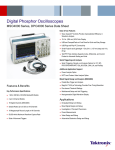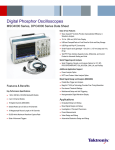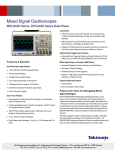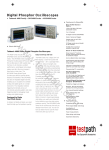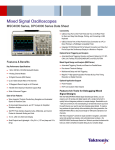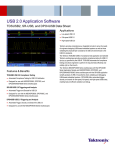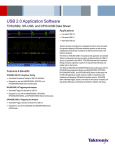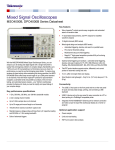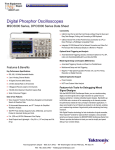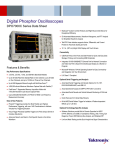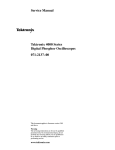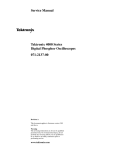Download Specs - TRS
Transcript
Digital Phosphor Oscilloscopes Tektronix 4000 Series Family • DPO4000 Series • MSO4000 Series Features & Benefits Key Performance Specs – 1 GHz, 500 MHz, 350 MHz Bandwidth Models – 2- or 4- Channel Digital Phosphor Oscilloscopes – 16 Digital Channels (MSO4000) – Suite of Advanced Triggers – Sample Rates Up to 5 GS/s on All Channels – 10 Megasample Record Length on All Channels – 35,000 wfm/s Maximum Waveform Capture Rate Tektronix 4000 Series Family. Tektronix 4000 Series Digital Phosphor Oscilloscopes The 4000 Series family includes the DPO4000 Series and the MSO4000 Series. The DPO4000 Series Digital Phosphor Oscilloscopes (DPOs) are the first oscilloscopes to offer usable deep memory on all channels, excellent performance, serial trigger and analysis options and all in the most compact form factor in their class. The MSO4000 Series Mixed Signal Oscilloscopes (MSOs) provide all the features and benefits of the DPO4000, but add 16 integrated digital channels, enabling you to visualize and correlate analog and digital signals on a single instrument. This integration extends triggering functionality across all 20 channels providing pattern and state triggering, ideal for debugging mixed analog and digital designs. Designed to Make Your Work Easier As design complexity increases, you need tools that help you find problems quickly. Easy to Set up and Use The 4000 Series has a large 10.4-inch XGA display, a clean front panel with familiar knobs – all in a package that is only 5.4" deep and weighs only 11 lbs. With USB plug-and-play operation and PC connectivity, acquiring data and measurements from the instrument is as simple as connecting a USB cable from the oscilloscope to the PC. Provided applications include National Instruments SignalExpress™ Tektronix Edition, OpenChoice® Desktop and Microsoft Excel and Word toolbars, enabling fast and easy direct communication with your Windows PC. USB and CompactFlash ports on the front panel enable simple transfer of screenshots, instrument settings and waveform data in the palm of your hand. When it comes to mixed signal design and debug, you want your instrument to be intuitive so you can start solving problems quickly. The MSO4000 Series drives like an oscilloscope, the tool you already know how to use. You do not have to relearn how to use the instrument every time you turn it on. Ease-of-Use Features – Wave Inspector® Controls Provide Unprecedented Efficiency in Waveform Analysis – 10.4 in. (264mm) XGA Color Display – Small Footprint and Light Weight – Only 5.4 in. (137mm) Deep and 11 lbs. (5 kg) – USB and CompactFlash on Front Panel for Quick and Easy Storage – Plug-and-Play PC Connectivity Serial Triggering and Analysis – I2C, SPI, CAN and RS-232/422/ 485/UART Serial Triggering and Analysis Options Mixed Signal Design and Analysis (MSO4000) – Parallel Bus Trigger and Analysis – MagniVu™ 60.6 ps Technology Provides Finer Timing Resolution – Per-channel Threshold Settings – Multi-channel Setup and Hold Triggering – Next-generation Digital Waveform Display Applications Embedded Design and Debug Mixed Signal Design and Debug Investigation of Transient Phenomena Power Measurements Video Design and Debug Automotive Electronics Digital Phosphor Oscilloscopes Tektronix 4000 Series Family • DPO4000 Series • MSO4000 Series Wave Inspector® controls provide unprecedented efficiency in viewing, navigating and analyzing waveform data. Wave Inspector controls. Wave Inspector Navigation Imagine trying to efficiently use the Internet if search engines such as Google and Yahoo didn’t exist, web browser features such as Favorites and Links didn’t exist or Internet Service Providers like AOL or MSN weren’t around. Now you know how most modern oscilloscope users feel when trying to actually use the long record length in their digital oscilloscope. Record length, one of the key specifications of an oscilloscope, is the number of samples it can digitize and store in a single acquisition. The longer the record length, the longer the time window you can capture with high timing resolution (high sample rate). The first digital oscilloscopes could capture and store only 500 points, which made it very difficult to acquire all relevant information around the event being investigated. Over the years, oscilloscope vendors have provided longer and longer record lengths to meet market demands for long capture windows with high resolution, to the point that most midrange oscilloscopes either come standard with, or can be optionally upgraded to, multi-mega-point record lengths. These mega-point record lengths often represent thousands of screens worth of signal activity. While standard record lengths 2 have increased greatly over the years and can now satisfy the vast majority of applications in the market-place, tools for effectively and efficiently viewing, navigating and analyzing long record length acquisitions have been sorely neglected until now. The Tektronix 4000 Series redefines expectations for working with long record lengths with the following innovative Wave Inspector controls: Zoom/Pan – A dedicated, two-tier frontpanel knob provides intuitive control of both zooming and panning. The inner knob adjusts the zoom factor (or zoom scale); turning it clockwise activates zoom and goes to progressively higher zoom factors, while turning it counter-clockwise results in lower zoom factors and eventually turning zoom off. The outer knob pans the zoom box across the waveform to quickly get to the portion of the waveform you are interested in. The outer knob also utilizes force-feedback to determine how fast to pan on the waveform. The farther you turn the outer knob, the faster the zoom box moves. Pan direction is changed by simply turning the knob the other way. No longer do you need to navigate through multiple menus to adjust your zoom view. Digital Phosphor Oscilloscopes • www.tektronix.com/oscilloscopes P6516 Mixed Signal Oscilloscope probe. Play/Pause – A dedicated play/pause button on the front panel scrolls the waveform across the display automatically while you look for anomalies or an event of interest. Playback speed and direction are controlled using the intuitive pan knob. Once again, turning the knob further makes the waveform scroll faster and changing direction is as simple as turning the knob the other way. User Marks – See something interesting on your waveform? Press the Set Mark button on the front panel to leave one or more “bookmarks” on the waveform. Navigating between marks is as simple as pressing the Previous and Next buttons on the front panel. Search Marks – Don’t want to take the time to inspect the entire acquisition to find the event you’re looking for? The 4000 Series features a robust waveform search feature that allows you to search through your long acquisition based on user-defined criteria. All occurrences of the event are highlighted with search marks and are easily navigated to, using the front panel Previous and Next buttons. Search types include edge, pulse width, runt, logic, setup and hold, rise/ fall time and parallel, I2C, SPI, RS-232/ 422/485/UART and CAN packet content. Digital Phosphor Oscilloscopes Tektronix 4000 Series Family • DPO4000 Series • MSO4000 Series P6516 MSO Probe This unique probe design offers two eight-channel pods. Each channel ends with a new probe tip design that includes a recessed ground for simplified connection to the device-under-test. This sleek new probe simplifies the process of connecting to the device-under-test. The coax on the first channel of each pod is colored blue making it easy to identify. The common ground uses an automotive style connector making it easy to create custom grounds for connecting to the device-under-test. When connecting to square pins, the P6516 has an adapter that attaches to the probe head extending the probe ground flush with the probe tip so you can attach to a header. The P6516 offers outstanding electrical characteristics applying only 3 pF of loading. The Power to Solve Problems Quickly The Performance and Feature Set You Expect The 4000 Series Digital Phosphor Oscilloscopes (DPO) deliver the performance you need to visualize even your most demanding signals. Bandwidths range from 350 MHz to 1 GHz, and with all models offering a minimum of 5x over-sampling on all channels and sin(x)/x interpolation standard, you can be confident that even the fastest transient events will be captured and displayed accurately. The standard 10 M record length on all channels enables you to capture long windows of signal activity while maintaining fine timing resolution. Multi-channel setup-and-hold triggering highlighting multiple violations (MSO4000). The 4000 Series offers a variety of analytical solutions including cursors, 25 automatic measurements, statistics and waveform math. Despite a tiny footprint (only 5.4 in. deep) and light weight (11 lbs.), the 4000 Series offers exceptional performance, a large 10.4 in. XGA display and knob-per-channel vertical controls. The TekVPI™ probe interface sets the standard for ease of use in probing. TekVPI probes feature status indicators and controls, as well as a probe menu button right on the comp box itself. This button brings up a probe menu on the oscilloscope display with all relevant settings and controls for the probe. The TekVPI interface utilizes a new probe power management architecture enabling direct attachment of current probes without requiring a separate, bulky power supply. Finally, TekVPI probes can be controlled remotely via USB, GPIB or Ethernet, enabling more versatile solutions in ATE environments. Triggering on a specific data packet going across an RS-232 bus. Bus waveform provides decoded packet content displayed in ASCII. MagniVu™ The main digital acquisition mode on the MSO4000 Series will capture up to 10 M points at 500 MS/s (2 ns resolution). In addition to the main record, the MSO4000 provides an ultra high resolution mode called MagniVu which acquires 10,000 points at up to 16.5 GS/s (60.6 ps resolution). Both main and MagniVu waveforms are acquired on every trigger and can be switched between at any time, running or stopped. MagniVu provides close to ten times finer timing resolution than any other MSO on the market, instilling confidence when making critical timing measurements on digital waveforms. Digital Phosphor Oscilloscopes • www.tektronix.com/oscilloscopes 3 Digital Phosphor Oscilloscopes Tektronix 4000 Series Family • DPO4000 Series • MSO4000 Series Serial Triggering and Analysis One of the most common applications requiring long record length is serial data analysis in embedded system design. Embedded systems are literally everywhere. They can contain many different types of devices including microprocessors, microcontrollers, DSPs, RAM, EPROMs, FPGAs, ADCs, DACs and I/O. These various devices have traditionally communicated with each other and the outside world using wide parallel buses. Today, however, more and more embedded systems are replacing these wide parallel buses with serial buses due to lower board space requirements, fewer pins, lower power, embedded clocks, differential signaling for better noise immunity, and most importantly, lower cost. In addition, there’s a large supply of off-the-shelf building block components from reputable manufacturers, enabling rapid design development. While serial buses have a large number of benefits, they also present significant challenges that their predecessors (parallel buses) did not face. They make debugging bus and system problems more difficult, it’s harder to isolate events of interest, and it’s more difficult to interpret what is displayed on the oscilloscope screen. The 4000 Series addresses these challenges and represents the ultimate tool for engineers working with low-speed serial buses such as I2C, SPI, RS-232/422/485/UART and CAN. 4 Bus Display – Provides a higher level, combined view of the individual signals (clock, data, chip enable, etc.), that make up your bus, making it easy to identify where packets begin and end and identifying sub-packet components such as address, data, identifier, CRC, etc. Serial Triggering – Trigger on packet content such as start of packet, specific addresses, specific data content, unique identifiers, etc., on popular low-speed serial interfaces such as I2C, SPI, RS-232/ 422/485/UART and CAN. Bus Decoding – Tired of having to visually inspect the waveform to count clocks, determine if each bit is a 1 or a 0, combine bits into bytes and determine the hex value? Let the oscilloscope do it for you! Once you’ve set up a bus, the oscilloscope will decode each packet on the bus, and display the value in either hex, binary or ASCII (RS-232/422/485/ UART only) in the bus waveform. Event Table – In addition to seeing decoded packet data on the bus waveform itself, you can view all captured packets in a tabular view much like you would see on a logic analyzer. Packets are listed consecutively with columns for each component (Address, Data, etc.). Digital Phosphor Oscilloscopes • www.tektronix.com/oscilloscopes Packet decode table showing decoded Identifier, DLC, Data and CRC for every CAN packet in a long acquisition. Search – Serial triggering is very useful for isolating the event of interest, but once you’ve captured it and need to analyze the surrounding data, what do you do? In the past, you had to manually scroll through the waveform, counting and converting bits and looking for what caused the event. With the 4000 Series, you can have the oscilloscope search through the acquired data for user-defined criteria including serial packet content. Each occurrence is highlighted by a search mark. Rapid navigation between marks is as simple as pressing the Prev and Next buttons on the front panel. Digital Phosphor Oscilloscopes Tektronix 4000 Series Family • DPO4000 Series • MSO4000 Series Mixed Signal Design and Analysis (MSO4000) As an embedded design engineer, you are faced with the challenge of everincreasing system complexity. A typical embedded design may incorporate various analog signals, high- and lowspeed serial digital communication and microprocessor buses, just to name a few. Serial protocols such as I2C and SPI are used frequently for chip-to-chip communication, but parallel buses are still used in many applications. Microprocessors, FPGAs, Analog-to-Digital Converters (ADCs) and Digital-to-Analog Converters (DACs) are all examples of ICs that present unique measurement challenges in today’s embedded designs. The MSO4000 Series Mixed Signal Oscilloscopes offer the addition of 16 digital channels. These channels are tightly integrated into the oscilloscope’s user interface, simplifying operation and making it possible to solve mixed signal issues more easily. Next Generation Digital Waveform Display In a continued effort to make mixed signal oscilloscopes easy to use, the MSO4000 Series has redefined the way you view digital waveforms. One common problem shared by both logic analyzers and mixed signal oscilloscopes is determining if data is a one or a zero when zoomed in far enough that the digital trace stays flat White edges indicate additional information is available by zooming in. Groups are created by simply placing digital channels together on the screen. You can position and set threshold values for a group in a single step. all the way across the display. The MSO4000 has color-coded the digital traces, displaying ones in green and zeros in blue. The MSO4000 has multiple transition detection hardware. When the system detects multiple transitions, the user will see a white edge on the display. White edges indicate that more information is available by zooming in or acquiring at faster sampling rates. In most cases zooming in will reveal the pulse that was not viewable at the previous settings. If the white edge is still present after zooming in as far as possible, this indicates that increasing your sample rate on the next acquisition will reveal higher frequency information than your previous settings could acquire. Channel setup on an MSO can often be time-consuming as compared to the traditional oscilloscope. This process often includes probing the device-under-test, Clocked parallel bus display, decoding a 7 bit counter. labeling the channels and positioning the channels on screen. The MSO4000 simplifies this process by allowing the user to group digital waveforms. By simply placing digital waveforms next to each other, they form a group. Once a group is formed, you can position all the channels contained in that group together. This greatly reduces the normal setup time associated with positioning channels individually. Digital Phosphor Oscilloscopes • www.tektronix.com/oscilloscopes 5 Digital Phosphor Oscilloscopes Digital Phosphor Oscilloscopes Tektronix 4000 Series Family • DPO4000 Series • MSO4000 Series Tektronix 4000 Series Family • DPO4000 Series • MSO4000 Series 3 1 1 Zoom/Pan – Dedicated front panel controls for zooming and panning. The inner knob controls zoom factor while the outer ring pans the zoom box across the waveform. Navigating your waveform has never been easier. 2 6 2 Marks – Want to mark your waveform for future reference or for quick navigation between events of interest? Simply press the Set Mark button to place “bookmarks” on your waveform. Use the next and previous buttons to navigate through user marks and search generated marks. 8 3 Search – Tired of turning the horizontal position knob endlessly on your current oscilloscope to find the event you’re looking for? Use the 4000’s powerful Search feature to find and mark all occurrences of an event based on user specified criteria. Search types include edge, pulse width, runt, logic, multi-channel setup and hold, rise/fall time and parallel, I2C, SPI, RS-232/422/485/UART and CAN packet content. 4 2 or 4 Analog Channels and 16 Digital Channels – View and trigger on up to 20 timecorrelated signals on the same display. (16 Digital Channels are only available on MSO models.) 9 7 5 Parallel and Serial Buses – Trigger on parallel or serial packet level content, view acquired data as a bus with all data decoded into hex, binary or ASCII, search through acquisitions for specific content and even view all decoded data in a tabular format, much like you would see on a logic analyzer. Standards supported include I2C, SPI, RS-232/422/485/UART and CAN. Analyze up to two buses on the DPO4000 and four on the MSO4000 at the same time. 6 Stunning Display – The 4000 Series boasts the largest and highest resolution display of any oscilloscope in its class at 10.4 in. (264 mm) and 1,024x768 resolution (XGA). 5 Only 5.4 in. Deep! – Despite the impressive performance, huge display and knob-per-channel controls, the 4000 Series is only 5.4 in. (137 mm) deep. 4 7 Mass Storage – Use the front panel USB and CompactFlash ports for simple and convenient storage of screenshots, waveform data and oscilloscope setups. Two more USB host ports are available on the rear panel for peripheral connections as well as a USB device port for instrument control using USBTMC. 8 Vertical Controls – Knob-per-channel vertical controls provide simple and intuitive operation. No longer do you need to share one set of vertical controls across all four channels! 9 TekVPI™ – TekVPI probe interface provides for direct connect current probes, intuitive comp box controls, remote control of probe settings and smarter communication between the oscilloscope and the probe. (Parallel is only available on MSO models.) See the 4000 Series in action for yourself. Try out the MSO4000 Virtual Oscilloscope at: www.tektronix.com/virtualmso 6 Digital Phosphor Oscilloscopes • www.tektronix.com/oscilloscopes Digital Phosphor Oscilloscopes • www.tektronix.com/oscilloscopes 7 Digital Phosphor Oscilloscopes Tektronix 4000 Series Family • DPO4000 Series • MSO4000 Series Other Applications Video Design and Development Many video engineers have remained loyal to analog oscilloscopes, believing the intensity gradations on an analog display are the only way to see certain video waveform details. The 4000 Series fast waveform capture rate, coupled with its intensity-graded view of the signal, provides the same informationrich display as an analog oscilloscope, but with much more detail and all the benefits of digital scopes. Standard features such as IRE and mV graticules, holdoff by fields, video polarity and an Autoset smart enough to detect video signals, make the 4000 Series the easiest to use oscilloscope on the market for video applications. And with up to 1 GHz bandwidth and four analog inputs, the 4000 Series provides ample performance for analog and digital video use. Finally, the 4000 Series video functionality is further extended with the optional DPO4VID video application module. DPO4VID provides the industry’s most complete suite of HDTV and custom (non-standard) video triggers. 8 OpenChoice® Desktop – Standard software seamlessly connects the 4000 Series to a PC. National Instruments SignalExpress™ Tektronix Edition – Fully interactive measurement acquisition and analysis software developed jointly with NI and optimized for the 4000 Series. Digital Phosphor Oscilloscopes • www.tektronix.com/oscilloscopes Viewing an NTSC video signal. Notice the intensity-graded view provided by the DPO’s ability to represent time, amplitude and distribution of amplitude over time. Fast waveform capture rate maximizes the probability of capturing elusive glitches and other infrequent events. Digital Phosphor Oscilloscopes Tektronix 4000 Series Family • DPO4000 Series • MSO4000 Series Characteristics Vertical System Analog Channels Input Channels Analog Bandwidth (–3 dB) 5 mV/div to 1 V/div Calculated Rise Time 5 mV/div (typical) DPO4032 MSO4032 DPO4034 MSO4034 DPO4054 MSO4054 DPO4104 MSO4104 2 4 4 4 350 MHz 350 MHz 500 MHz 1 GHz 1 ns 1 ns 700 ps 350 ps Hardware Bandwidth Limits 20 MHz or 250 MHz Input Coupling AC, DC, GND Input Impedance 1 MΩ ±1%, 50 Ω ±1% Input Sensitivity, 1 MΩ 1 mV/div to 10 V/div Input Sensitivity, 50 Ω 1 mV/div to 1 V/div Vertical Resolution 8 bits (11 bits with Hi Res) Max Input Voltage, 1 MΩ 250 VRMS with peaks ≤ ± 400 V Max Input Voltage, 50 Ω 5 VRMS with peaks <±20 V DC Gain Accuracy ±1.5% with offset set to 0 V Offset Range 1 MΩ 50 Ω 1 mV/div to 50 mV/div ±1 V ±1 V 50.5 mV/div to 99.5 mV/div ±0.5 V ±0.5 V 100 mV/div to 500 mV/div ±10 V ±10 V 505 mV/div to 995 mV/div ±5 V ±5 V 1 V/div to 5 V/div ±100 V ±5 V 5.05 V/div to 10 V/div ±50 V NA Channel-to-Channel Isolation Vertical System Digital Channels Input channels Thresholds Threshold Selections User-defined Threshold Range Maximum Input Voltage ≥100:1 at ≤100 MHz and ≥30:1 at >100 MHz up to the rated bandwidth for any two channels having equal volts/div settings MSO4032 MSO4034 MSO4054 MSO4104 16 Digital (D15 to D0) Per-channel thresholds TTL, CMOS, User-defined +5 to –2V ±15 V Threshold Accuracy ±(100 mV + 3% of threshold setting) Input Dynamic Range 6 Vp-p centered around the threshold Minimum Voltage Swing 500 mV Input Impedance 20 kΩ Probe Loading 3 pF Vertical Resolution 1 bit Digital Phosphor Oscilloscopes • www.tektronix.com/oscilloscopes 9 Digital Phosphor Oscilloscopes Tektronix 4000 Series Family • DPO4000 Series • MSO4000 Series Horizontal System Analog Channels DPO4032 MSO4032 DPO4034 MSO4034 DPO4054 MSO4054 DPO4104 MSO4104 Maximum Sample Rate (all channels) 2.5 GS/s 2.5 GS/s 2.5 GS/s 5 GS/s Minimum Peak Detect Pulse Width 400 ps 200 ps Maximum Record Length (all channels) 10 M points Maximum Duration at Highest Sample Rate (all channels) 4 ms Timebase Range 4 ms 4 ms 1 ns to 1,000 s Timebase Delay Time Range 400 ps to 1,000 s –10 divisions to 50 s Channel-to-Channel Deskew Range ±100 ns Timebase Accuracy ±5 ppm over any ≥1 ms interval Horizontal System Digital Channels MSO4032 Maximum Sample Rate (Main) Maximum Record Length (Main) MSO4034 MSO4054 10 M points 16.5 GS/s (60.6 ps resolution) Maximum Record Length (MagniVu) 10 k points centered on the trigger Minimum Detectable Pulse Width Channel-to-Channel Skew Trigger System Main Trigger Modes – Auto, Normal and Single. Trigger Coupling – DC, HF reject (attenuates >50 kHz), LF reject (attenuates <50 kHz), noise reject (reduces sensitivity). Trigger Holdoff Range – 20 ns to 8 s. Sensitivity Internal DC Coupled – 0.4 div DC to 50 MHz, increasing to 1 div at rated bandwidth. External (Auxiliary Input) – 200 mV from DC to 50 MHz increasing to 500 mV at 250 MHz. Trigger Level Range Any Channel – ±8 divisions from center of screen. External (auxiliary input) – ±8V. Trigger Modes Edge – Positive or negative slope on any channel or front panel auxiliary input. Coupling includes DC, HF reject, LF reject and noise reject. Sequence (B-trigger) – Trigger Delay by Time – 4 ns to 8 s. Or Trigger Delay by Events – 1 to 9,999,999 events. Pulse Width – Trigger on width of positive or negative pulses that are >, <, = or ≠ a specified period of time. Runt – Trigger on a pulse that crosses one threshold but fails to cross a second threshold before crossing the first again. Logic – Trigger when any logical pattern of channels goes false or stays true for specified period of time. Any input can be used as a clock to look for the pattern on a clock edge. Pattern (AND, OR, NAND, NOR) specified for all analog and digital input channels defined as High, Low or Don’t Care. MSO4104 500 MS/s (2 ns resolution) Maximum Sample Rate (MagniVu™) 10 2 ms 1.5 ns 60 ps typical Setup and Hold – Trigger on violations of both setup time and hold time between clock and data present on any of the input channels. Rise/Fall Time – rigger on pulse edge rates that are faster or slower than specified. Slope may be positive, negative or either. Video – Trigger on line number, all lines, odd, even or all fields on NTSC, PAL and SECAM video signals. Extended Video (optional) – Trigger on 480p/60, 576p/50, 720p/30, 720p/50, 720p/60, 875i/60, 1080i/50, 1080i/60, 1080p/24, 1080p/24sF, 1080p/25, 1080p/30, 1080p/50, 1080p/60 and custom bi-level and tri-level sync video standards. I 2C (optional) – Trigger on Start, Repeated Start, Stop, Missing ACK, Address (7 or 10 bit), Data or Address and Data on I 2C buses up to 3.4 Mb/s. SPI (optional) – Trigger on SS, MOSI, MISO or MOSI and MISO on SPI buses up to 50.0 Mb/s (not available on DPO4032). CAN (optional) – Trigger on Start of Frame, Frame Type (data, remote, error, overload), Identifier (standard or extended), Data, Identifier and Data, End of Frame or Missing ACK on CAN signals up to 1 Mb/s. Data can be further specified to trigger on ≤, <, =, >, ≥ or ≠ a specific data value. User-adjustable sample point is set to 50% by default. RS-232/422/485/UART (optional) – Trigger on Tx start bit, Rx start bit, Tx end of packet, Rx end of packet, Tx data, Rx data. Parallel (available on MSO models only) – Trigger on a parallel bus data value. Digital Phosphor Oscilloscopes • www.tektronix.com/oscilloscopes Acquisition Modes Sample – Acquires sampled values. Peak Detect – Captures glitches as narrow as 200 ps at all sweep speeds. Averaging – From 2 to 512 waveforms included in average. Envelope – Min-max envelope reflecting Peak Detect data over multiple acquisitions. Hi Res – Real-time boxcar averaging reduces random noise and increases vertical resolution. Roll Scrolls waveforms right to left across screen at sweep speeds slower than or equal to 40ms/div. Waveform Measurements Cursors – Waveform and Screen. Automatic Measurements – 25, of which up to four can be displayed on screen at any one time. Measurements include Period, Frequency, Delay, Rise Time, Fall Time, Positive Duty Cycle, Negative Duty Cycle, Positive Pulse Width, Negative Pulse Width, Burst Width, Phase, Positive Overshoot, Negative Overshoot, Peak to Peak, Amplitude, High, Low, Max, Min, Mean, Cycle Mean, RMS, Cycle RMS, Area and Cycle Area. Measurement Statistics – Mean, Min, Max, Standard Deviation. Reference Levels – User-definable reference levels for automatic measurements can be specified in either percent or units. Gating – Isolate the specific occurrence within an acquisition to take measurements, using either the screen or waveform cursors. Digital Phosphor Oscilloscopes Tektronix 4000 Series Family • DPO4000 Series • MSO4000 Series Ordering Information Arithmetic – Add, subtract, multiply and divide waveforms. Math Functions – Integrate, Differentiate, FFT. FFT – Spectral magnitude. Set FFT Vertical Scale to Linear RMS or dBV RMS, and FFT Window to Rectangular, Hamming, Hanning or Blackman-Harris. Advanced Math – Define extensive algebraic expressions including analog waveforms, math functions, scalars, up to two user-adjustable variables and results of parametric measurements e.g., (Intg (Ch1-Mean(Ch1)) x 1.414 x VAR1). XGA Video Port – DB-15 female connector, connect to show the oscilloscope display on an external monitor or projector. Auxiliary Input – Front panel BNC connector. Input Impedance 1 MΩ. Max input 250 VRMS with peaks ±400 V. Probe Compensator Output – Front panel pins. Amplitude 2.5 V – Frequency 1 kHz. Trigger Out – Rear-panel BNC connector, provides a positive polarity pulse when the oscilloscope triggers. Kensington Lock – Rear-panel security slot connects to standard Kensington lock. Software Power Source MSO4000 Models National Instruments SignalExpress Tektronix Edition – A fully interactive measurement software environment optimized for the 4000 Series, enables you to instantly acquire, generate, analyze, compare, import and save measurement data and signals using an intuitive drag-and-drop user interface that does not require any programming. Standard 4000 Series support for acquiring, controlling, viewing and exporting your live signal data is permanently available through the software. The Professional version adds additional signal processing, advanced analysis, mixed signal, sweeping, limit testing and user-defined step capabilities and is available for a 30-day trial period standard with each instrument. OpenChoice® Desktop – Enables fast and easy communication between a Windows PC and the 4000 Series via USB or LAN. Transfer and save settings, waveforms, measurements and screen images. IVI Driver – Provides a standard instrument programming interface for common applications such as LabVIEW, LabWindows/CVI, Microsoft .NET and MATLAB. Power Source Voltage – 100 to 240 V ±10% Power Source Frequency – 47 to 66 Hz (90 to 264 V), 360 to 440 Hz (100 to 132 V). Power Consumption – 250 W maximum. MSO4032 – 350 MHz, 2.5 GS/s, 10 M record length, 2+16 channel mixed signal oscilloscope. MSO4034 – 350 MHz, 2.5 GS/s, 10 M record length, 4+16 channel mixed signal oscilloscope. MSO4054 – 500 MHz, 2.5 GS/s, 10 M record length, 4+16 channel mixed signal oscilloscope. MSO4104 – 1 GHz, 5 GS/s, 10 M record length, 4+16 channel mixed signal oscilloscope. All models include: One P6139A 500 MHz, 10x Passive Probe per Analog Channel, Front Cover (200-4908-00), CompactFlash Memory Card; 32 MB (156-9413-00), User Manual, Documentation CD (063-3903-00), OpenChoice® Desktop Software, National Instruments SignalExpress Tektronix Edition Software, Calibration certificates document measurement traceability to National Metrology Institute(s) – the Quality System this product is manufactured in is ISO9001 registered, power cord, accessory bag (016-1967-00) and a threeyear warranty. Please specify power plug and manual version when ordering. MSO models also include one P6516 16-channel logic probe and a logic probe accessory kit (020-2662-xx). Waveform Math Physical Characteristics Dimensions mm in Height 229 9 Width 439 17.3 Depth 137 5.4 Weight kg lbs Net 5 11 Shipping 9.5 22 Rackmount Configuration 5U Cooling Clearance 2 in. (51mm) required on left side and rear of instrument General Characteristics Environmental Temperature Display Characteristics Display Type – 10.4 in. (264mm) liquid crystal TFT color display. Display Resolution – 1024 horizontal x 768 vertical pixels (XGA). Waveform Styles – Vectors, Dots, Variable Persistence, Infinite Persistence. Graticules – Full, Brid, Cross Hair, Frame, IRE and mV. Format – YT and simultaneous XY/YT. Waveform Capture Rate – Up to 35,000 wfms/sec. Operating – 0 ºC to +50 ºC. Non-operating – –20 ºC to +60 ºC. Humidity Operating – High: 40 ºC to 50 ºC, 10% to 60% relative humidity. Low: 0 ºC to 40 ºC, 10% to 90% relative humidity. Non-operating – High: 40 ºC to 60 ºC, 5% to 60% relative humidity. Low: 0 ºC to 40 ºC, 5% to 90% relative humidity. Input/Output Ports Altitude CompactFlash Drive – Front panel access (Type 1) USB2.0 Full Speed Host Port – Supports USB mass storage devices, printers and keyboard. Two ports available on rear-panel and one on front-panel. USB 2.0 High Speed Device Port – Rear panel connector allows for control of oscilloscope via USBTMC or GPIB with a TEK-USB-488. LAN Port – RJ-45 connector, supports 10/100Base-T. Operating – 3,000 meters (9,843 feet). Non-operating – 12,000 meters (39,370 feet). Random Vibration Operating – 0.31 GRMS from 5 to 500 Hz, 10 minutes each axis, 3 axes, 30 minutes total. Non-operating – 2.46 GRMS from 5 to 500 Hz, 10 minutes each axis, 3 axes, 30 minutes total. Regulatory Electromagnetic Compatibility – 89/336/EEC Safety – UL61010-1, Second Edition; CSA61010-1 Second Edition, EN61010-1:2001; IEC 61010-1:2001. DPO4000 Models DPO4032 – 350 MHz, 2.5 GS/s, 10 M record length, 2-channel digital phosphor oscilloscope. DPO4034 – 350 MHz, 2.5 GS/s, 10 M record length, 4-channel digital phosphor oscilloscope. DPO4054 – 500 MHz, 2.5 GS/s, 10 M record length, 4-channel digital phosphor oscilloscope. DPO4104 – 1 GHz, 5 GS/s, 10 M record length, 4-channel digital phosphor oscilloscope. Application Modules DPO4AUTO – Automotive Serial Triggering and Analysis Module. Enables triggering on packet level information on CAN bus as well as analytical tools such as digital views of the signal, bus views, packet decoding, search tools and packet decode tables with timestamp information. DPO4EMBED – Embedded Serial Triggering and Analysis Module. Enables triggering on packet level information on I 2C and SPI buses as well as analytical tools such as digital views of the signal, bus views, packet decoding, search tools and packet decode tables with timestamp information. SPI support is available on all models except DPO4032. DPO4COMP – Computer Serial Triggering and Analysis Module. Enables triggering on packet level information on RS-232/422/485/UART buses as well as analytical tools such as digital views of the signal, bus views, packet decoding, search tools and packet decode tables with timestamp information. DPO4VID – HDTV and Custom (non-standard) Video Triggering Module. Digital Phosphor Oscilloscopes • www.tektronix.com/oscilloscopes 11 Digital Phosphor Oscilloscopes Contact Tektronix: ASEAN / Australasia (65) 6356 3900 Tektronix 4000 Series Family • DPO4000 Series • MSO4000 Series Austria +41 52 675 3777 Balkan, Israel, South Africa and other ISE Countries +41 52 675 3777 Belgium 07 81 60166 Instrument Options Power Plug Options Opt. A0 – North America. Opt. A1 – Universal Euro. Opt. A2 – United Kingdom. Opt. A3 – Australia. Opt. A5 – Switzerland. Opt. A6 – Japan. Opt. A10 – China. Opt. A11 – India. Opt. A99 – No power cord or AC adapter. Language Options*1 Opt. L0 – English manual. Opt. L1 – French manual. Opt. L2 – Italian manual. Opt. L3 – German manual. Opt. L4 – Spanish manual. Opt. L5 – Japanese manual. Opt. L6 – Portuguese manual. Opt. L7 – Simplified Chinese manual. Opt. L8 – Standard Chinese manual. Opt. L9 – Korean manual. Opt. L10 – Russian manual. Opt. L99 – No manual. Service Options*2 Opt. C3 – Calibration service 3 years. Opt. C5 – Calibration service 5 years. Opt. CA1 – Provides a single calibration event or coverage for the designated calibration interval, whichever comes first. Opt. D1 – Calibration Data Report. Opt. D3 – Calibration Data Report 3 years (with Opt. C3). Opt. D5 – Calibration Data Report 5 years (with Opt. C5). Opt. R5 – Repair service 5 years (including warranty). Brazil & South America (11) 40669400 Recommended Probes Canada 1 (800) 661-5625 TAP1500 – 1.5 GHz TekVPI™ active probe. ™ Central East Europe, Ukraine and the Baltics +41 52 675 3777 TDP0500 – 500 MHz TekVPI 42 V differential probe. Central Europe & Greece +41 52 675 3777 TDP1000 – 1 GHz TekVPI 42 V differential probe. Denmark +45 80 88 1401 TCP0030 – 120 MHz TekVPI 30 Ampere AC/DC Finland +41 52 675 3777 current probe. France +33 (0) 1 69 86 81 81 *3 TCPA300/400 – Current measurement systems. Germany +49 (221) 94 77 400 P6246*3 – 400 MHz differential probe. Hong Kong (852) 2585-6688 P6247*3 – 1.0 GHz differential probe. India (91) 80-22275577 P5205*3 – 1.3 kV, 100 MHz high-voltage differenItaly +39 (02) 25086 1 tial probe. Japan 81 (3) 6714-3010 P5210*3 – 5.6 kV, 50 MHz high-voltage differenLuxembourg +44 (0) 1344 392400 tial probe. Mexico, Central America & Caribbean 52 (55) 5424700 P5100 – 2.5 kV, 100X high-voltage passive Middle East, Asia and North Africa +41 52 675 3777 probe. The Netherlands 090 02 021797 ADA400A*3 – 100X, 10X, 1X, 0.1X high-gain Norway 800 16098 differential amplifier. People’s Republic of China 86 (10) 6235 1230 NEX-HD2HEADER – Mictor connector breakout Poland +41 52 675 3777 to 0.1" header pins. Portugal 80 08 12370 Recommended Accessories 071-1844-XX – Service manual (English only). SIGEXPTE – National Instruments SignalExpress™ Tektronix Edition Software Professional Edition. FPGAView-xx – MSO support for Altera and Xilinx FPGAs. TPA-BNC – TekVPI to TekProbe BNC adapter. TEK-USB-488 – GPIB to USB adapter. TLAHRA with (2) 196-3476-01 – High impedance adapter and leadsets for P6515 MSO probe. 119-6827-00 – CompactFlash to USB Memory Card Reader. AC4000 – Soft Transit Case. HCTEK4321 – Hard Transit Case (Requires AC4000). RM4000 – Rackmount kit. AMT75*3 – 1 GHz, 75 Ω adapter. Warranty Three-year warranty covering all parts and labor, excluding probes. *1 Language options include translated front panel overlay for the selected language(s). *2 Probes and accessories are not covered by the oscilloscope warranty and Service Offerings. Refer to the datasheet of each probe and accessory model for its unique warranty and calibration terms. *3 Requires TekVPI to TekProbe BNC adapter (TPA-BNC). Republic of Korea 82 (2) 6917-5000 Russia & CIS +7 (495) 7484900 South Africa +27 11 206 8360 Spain (+34) 901 988 054 Sweden 020 08 80371 Switzerland +41 52 675 3777 Taiwan 886 (2) 2722-9622 United Kingdom & Eire +44 (0) 1344 392400 USA 1 (800) 426-2200 For other areas contact Tektronix, Inc. at: 1 (503) 627-7111 Updated 01 June 2007 Our most up-to-date product information is available at: www.tektronix.com Product(s) are manufactured in ISO registered facilities. Product(s) complies with IEEE Standard 488.1-1987, RS-232-C, and with Tektronix Standard Codes and Formats. Copyright © 2007, Tektronix. All rights reserved. Tektronix products are covered by U.S. and foreign patents, issued and pending. Information in this publication supersedes that in all previously published material. Specification and price change privileges reserved. TEKTRONIX and TEK are registered trademarks of Tektronix, Inc. All other trade names referenced are the service marks, trademarks or registered trademarks of their respective companies. 7/07 HB/WOW 3GW-20156-1











